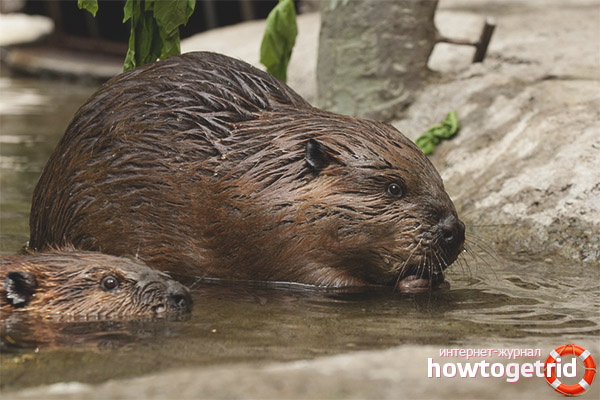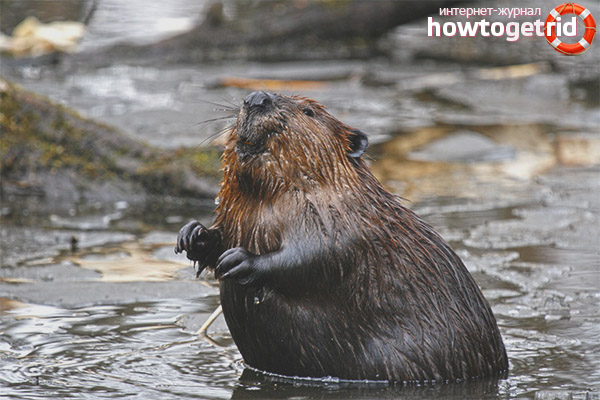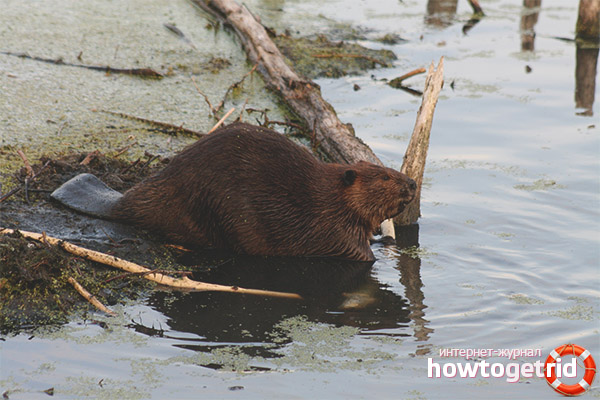The content of the article
Canadian beavers belong to the beaver family and are large-sized semi-aquatic rodents. Castor canadensis lives in North America. This rodent mammal takes 2nd place among rodents in size.
The habitat of Canadian beavers is almost the entire territory of North America. The habitat does not include northern Canada, the southern deserts of the United States of America, or the hot, Mexican deserts.
Description
Canadian beavers are the largest representatives of rodents, living in the rivers of the North American continent. Their sizes reach 117 cm in length. The coat of this animal is painted in dark shades of brown, it does not pass water. It has an attractive, rich appearance. The beaver's ears are small, rounded and dark brown in color. When moving, the front of the rodent is lower than the back. This feature is explained by the fact that the length of the hind legs is longer than that of the front.
The structure of the jaw and skull is disproportionate. The upper incisors are painted in a bright shade of orange, their width is more than 5 mm, and the length varies from 20 to 25 mm. The teeth located on the upper jaw grow throughout the life of the beaver. Biologists note that a powerful upper jaw, nostrils that have the ability to close, small ears, membranes located on the eyes, are a vital necessity for the Canadian beaver and help to survive in the wild habitat. Strong and sharp teeth help beavers gnaw trees, knocking them to the ground. With the help of powerful, front paws, rodents drag wood closer to their dwellings and build dams.
In rodent beavers of any gender, the presence of:
- Anal glands. The dimensions of the anal glands are 8.6 cm x 5.5 cm.
- Fur glands. Their dimensions are 7.6 cm x 2.4 cm.
The main task of the glands is labeling, which is carried out using a secreted substance with a strong odor. This feature distinguishes beavers from other representatives of rodents. The anal and fur glands are located near the tail. It is considered to be a hallmark of these animals. Its dimensions can reach 25 cm in length and 15 cm in width. The large, wide tail is covered with black scales.
Habitat
The permanent habitat of Canadian beavers are remote rivers, lakes and streams with a slow current. Rodents can slow down the flow by building dams from fallen trees. Animals are transported material for construction through the channels of their own creation. Underwater rodents also build their own homes. Beavers build several types of dwellings:
Mink Minks most often create Eurasian beavers, while Canadian ones prefer to settle in huts.
Huts. The huts are a floating structure made of brushwood, silt and earth. The height of an unusual building can be from 1 to 3 m, and the diameter of the hut in some cases reaches 10 meters. Beavers gnaw through several entrances, one of which will be underwater. The dwelling has a small opening, which provides free air penetration. Beavers gnaw him at the top of the house.
Rodents prepare the home for a cold snap, covering the hut with earth. During the first frosts, the earth freezes, creating strong protection against external environmental influences. In addition, the hut is covered with wood chips, tree bark and grass. The huts are used by beavers for relaxing at night, storing stocks. Rodents hide in a house from predatory animals.
Dams built by beavers from wood, stones of various sizes, wet earth and grass provide rodents with protection from predators. In addition, different types of fish, waterfowl and other animals living in the reservoir live on the dams. Construction helps reduce soil erosion and reduce the risk of flooding.
Despite all the positive properties, the dam is not a solid and permanent structure, and can exist only in the habitats of beavers, which will maintain it in good condition. Typically, the construction of dams begins with the approach of cold weather - in the autumn. Beavers that live in the northern regions can themselves destroy buildings. Such actions are explained by the need to reduce the water level in the reservoir, increase the oxygen content or get to the trees growing behind the dam. Otters and other animals can sometimes damage the integrity of buildings.
Beaver breeding

Canadian beavers are excellent family men, they live in pairs. These animals differ in monogamy, and the decay of the couple and the search for another partner is possible only in the event of the death of the previous partner. Independent life of rodents begins in the second year of life. By this time, beavers can independently provide themselves with food and build housing. Young individuals settle at a distance of at least 2 km from their parents and create their own family. The period of maturity begins after reaching the age of three in both females and males.
Canadian beavers produce offspring annually. The mating period varies by region. In the northern regions, it begins in January and lasts until the first spring month, in the southern - from November to December. The gestation period is 3 calendar months.
Cubs are born with open eyes and complete pubescence. The color of the baby's coat is brown with shades of black or red. Newborn beavers begin to swim 24 hours after the appearance, and after a few days, the beavers will learn how to completely submerge under water. Parents accompany offspring during the first swims and help to explore the area.
The weight of newborn Canadian beavers is from 250 to 600 g, and the length does not exceed 38 cm. The first month of life, the beavers spend in the hut, leaving it extremely rarely. Beavers are mammals and feed on breast milk during the first 2 weeks of life.
Beavers take care of their offspring. Parents protect beavers from predatory animals, provide food and introduce themselves to the surroundings. Young individuals receive the skills necessary for independent living from their parents throughout the entire period of cohabitation.
How many canadian beavers live
The life expectancy of Canadian beavers in the wild is 10-20 years. Often their lives are threatened by people and large predators. In addition, the beaver population in North America is declining due to the spread of some parasites and infectious diseases.
Food
The rodent's daily menu consists of bark and cambium. Beavers prefer willow, poplar, beech, maple, birch, aspen and alder. In addition, these animals can feed on the roots of fallen trees, buds and plants that grow in water.
Despite the fact that beavers are mammals, the main component of their diet is cellulose.
The diet of captive individuals consists of fresh carrots, yams, lettuce and specialized food.
Behavior features
Beavers live in families. The maximum number of individuals connected by blood relationship does not exceed 8. The first 2 years of life, the offspring live next to their parents. During this period, young beavers acquire the skills of building dams. In addition, the growing offspring monitors newborn beavers and takes part in collecting food.
Beavers protect their territory, both from predators and from other representatives of their species. Rodents mark their territory and show aggression to outsiders. Adults leave marks with a beaver stream. Slamming the tail against the water is used to warn of a potential threat.
Beavers are active in the evening, during the day these rodents emerge from the huts only in extreme cases. Rodents can leave their home for a long time during the collection and search for food. In the event that one of the family members finds a good source of food, rodents begin the construction of a canal for transporting food to the hut. For food in the winter, Canadian beavers make stocks from branches and logs.
Threat and enemies
Young individuals are vulnerable to many predators. The threat to beaver life comes from wolves, young and adult bears, lynxes and otters. In addition, the danger is a person. Beavers often die due to anglers.
Predatory animals fear adult representatives of the species, which is due to the size of the sexually mature beaver. Biologists say that the main threat to the life of beavers is man. The percentage of individuals that died from human hands is significantly higher than the percentage of deaths from predator attacks. People kill both young and adult beavers for the sake of their skins. In addition, the population of these rodents decreases due to the influence of human waste products on the natural habitat of beavers and general environmental pollution.
Positive and negative value
Positive economic values include the fact that in the last century, the fur of a semi-aquatic rodent was a serious trading unit. On its sale, it was possible to gain large amounts of money.
In addition, beavers have a beneficial effect on the environment, maintaining a stable groundwater level, controlling floods and erosion. Dams built by rodents are a comfortable place of residence for a variety of inhabitants of rivers and reservoirs.
A negative value is the fact that the flow of water slows down, which leads to significant changes in the flora and fauna of the reservoir and becomes the cause of siltation. Dams built by beavers in some cases cause flooding. This can lead to the loss of large areas of forests.
Security status
The population of Canadian beaver today does not cause concern among biologists. In the last century, beaver massacres have led to a decrease in the population. This led to the disappearance of rodents from many habitats and a decrease in population.
Rodents were on the verge of extinction, which is why it was decided to artificially populate Canadian beavers in their former places. This helped correct the situation and prevented the extinction of the species.
Video: Canadian Beaver (Castor canadensis)












Submit